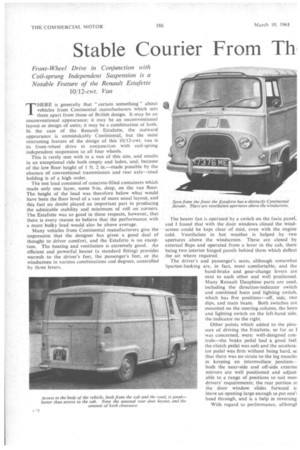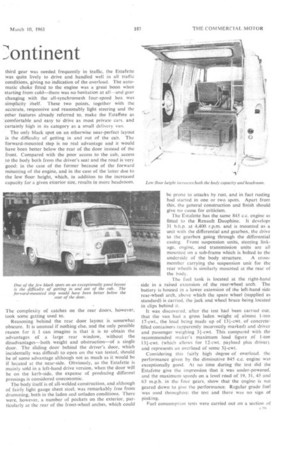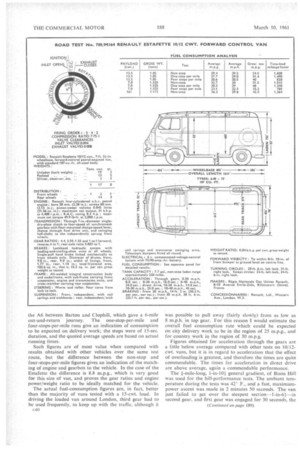Stable Courier From Th
Page 76

Page 77

Page 78

Page 81

If you've noticed an error in this article please click here to report it so we can fix it.
-2ontinent
Front-Wheel Drive in Conjunction with Coil-sprung Independent Suspension is a Notable Feature of the Renault Estafette 10112-cwt. Van
THERE is generally that "certain something" about vehicles from Continental manufacturers which sets them apart from those of British design. It may be an unconventional appearance; it may be an unconventional layout or design of units; it may be a combination of both. In the case of the Renault Estafette, the outward appearance is unmistakably Continental, but the most interesting feature of the design of this 10/12-cwt. van is its front-wheel drive in conjunction with coil-spring independent suspension to all four wheels.
This is rarely met with in a van of this size, and results in an exceptional ride both empty and laden, and, because of the low floor height of 1 ft. 2 in.—made possible by the absence of conventional transmission and rear axle—road holding is of a high order.
The test load consisted of concrete-filled containers which made only one layer, some 9-in, deep, on the van floor. The height of the load was therefore below what would have been the floor level of a van of more usual layout, and this fact no doubt played an important part in producing the admirable stability and minimum of roll on 'corners. The Estafette was so good in these respects, however, that there is every reason to believe that the performance with a more bulky load would also be above average.
Many vehicles from Continental manufacturers give the impression that the designer has given a good deal of thought to driver comfort, and the Estafette is no exception. The heating and ventilation is extremely good. An efficient and powerful heater (a standard fitting) provides warmth to the driver's feet, the passenger's feet, or the windscreen in various combinations and degrees, controlled by three levers.
• The heater fan is opefated by a Switch on the facia panel; and I found that with the door windows closed the windscreen could be kept clear of mist, even with the engine cold. Ventilation in hot weather is helped . by two apertures above the windscreen. These are dosed by external flaps and operated from a lever in the cab, there being two interior hinged panels behind them which deflect the air where required.
The driver's and passenger's seats, although somewhat Spartan-looking are, in fact, most comfortable, and the hand-brake and gear-change levers are next to each other and well positioned. Many Renault Dauphine parts are used, including the direction-indicator switch and combined horn and lighting switch, which has five positions—off, side, two dips, and main beam. Both switches are mounted on the steering column, the horn and lighting switch on the left-hand side, the indicator On the right. .
Other points which added to the pleasure of driving the Estafette, so far as 1 was concerned, were: well-designed controls—the brake pedal had a good feel, the clutch pedal was soft and the accelerator pedal was firm without being hard, so that there was no strain to the leg muscle in keeping an intermediate Position— both the near-side and off-:side exteriot mirrors are well positioned and adjust. able to a range of positions to suit mosi drivers' requirements; the rear portion oi the door window slides forward tc leave an opening large enough to put one': head through, and is a help in reversing With regard to performance, althougl third gear was needed frequently in traffic, the Estafette was quite lively to drive and handled well in all traffic conditions, giving no indication of the overload. The automatic choke fitted to the engine was a great boon when starting from cold—there was no hesitation at all—and gear changing with the all-synchromesh four-speed _box was simplicity itself. These two points, together with the accurate, responsive and reasonably light steering and the other features already referred to, make the Estaffete as • comfortable and easy to drive as most private cars, and certainly high in its category as a small delivery van.
The only black spot on an otherwise near-perfect -layout is the difficulty of getting in and out of the cab. The forward-mounted step is no real advantage and it would have been better below the rear of the door instead of the front. Compared with the poor access to the cab, access to the body both from the driver's seat and the road is very good: in the case of the former because of the forward mounting of the engine, and in the case of the latter due to the low floor height,. which, in addition to the increased capacity for a.given exterior size, results in more headroom.
The complexity of catches on the rear doors, however, took some getting used to.
Reasoning behind the rear door layout is somewhat obscure. It is unusual if nothing else, and the only possible reason for it I can imagine is that it is to obtain the advantages of a large rear window, without the disadvantages—both weight and obstruction—of a single door. The sliding door behind the driver's door, which incidentally was difficult to open on the van tested, should be of some advantage although not as much as it would be if located at the near-side. Obviously, as the Estafette is mainly sold in a left-hand drive version, when the door will be on the kerb-side, the expense of producing different pressings is considered uneconomic.
The body itself is of all-welded construction, and although of fairly light gauge sheet steel, was remarkably free from drumming, both in the laden and unladen conditions. There were, however, a number of pockets on the exterior, particularly at the rear of the front-wheel arches, which could be prone to attacks by rust, and in fact rusting had started in one or two spots. Apart from this, the general construction and finish should give no cause for criticism.
The Estafette has the same 845 c.c. engine as fitted to the Renault Dauphine. It develops 31 b.h.p. at 4,400 r.p.m. and is mounted as a unit with the differential and gearbox, the drive to the gearbox going through the differential easing. Front suspension units, steering linkage, engine, and transmission units are all mounted on a sub-frame which is bolted to the
underside of the body structure, A crossmember carrying the suspension unit for the rear wheels is similarly mounted at the rear of the body.
The fuel tank is located at the right-hand side in a raised extension of the rear wheel arch. The battery is hOused in a lower extension of the left-hand side rear-wheel arch, above which the spare wheel (supplied as standard) is carried, the jack and wheel brace being located in clips behind it.
It was discovered, after the test had been carried out, that the van had a gross laden weight of almost 1-ton 17-cwt., the load being made up of l3-cwt. of concretefilled containers (apparently incorrectly .marked) and driver and passenger weighing 31-cwt. This compared with the recommended maker's maximum load figure of 1-ton 131-cwt. (which allows for 12-cwt. payload plus driver), and represents an overload of some 3-1-cwt.
Considering this fairly high degree of overload, the performance given by the diminutive 845 c.c. engine was exceptionally good. At no time _during the test did the Estafette give the impression -that it was under-powered. and the maximum speeds on a level road of 19, 31, 43 and 63 m.p.h. in the four gears show that the engine is not -geared down to give the performance. Regular grade fuel was used throughout the test arid there Was no sign of pinking, Fuel consumption tests were carried out on a section of r39 the A6 between Barton and Clophill, which gave a 6-mile out-and-return journey. The one-stop-per-mile and four-stops-per-mile runs give an indication of consumption to be expected on delivery work; the stops were of 15-sec. duration, and the quoted average speeds are based on actual running times.
Such figures are of most value when compared with results obtained with other vehicles over the same test route, but the difference between the non-stop and four-stops-per-mile figures gives an indication of the matching of engine and gearbox to the vehicle. In the case of the Estafette the difference is 8.8 m.p.g., which is very good for this size of van, and proves the gear ratios and engine power/weight ratio to be ideally matched for the vehicle.
The actual fuel-consumption figures are, in fact, better thanthe majority of vans tested with a 15-cwt. load. In driving the loaded van around London, third gear had to be used frequently, to keep up with the traffic, although it
c40
was possible to pull away (fairly slowly) from as low as 8 m.p.h. in top gear. For this reason I would estimate the overall fuel consumption rate which could be expected on city delivery work to be in the region of 25 m.p.g., and for country work in the region of 30 m.p.g.
Figures obtained for acceleration through the gears are a little 'belowaverage compared with other tests on 10/12cwt. vans, but it is in regard to acceleration that the effect of overloading is greatest, and therefore the times are quite commendable. The times for acceleration in direct drive are above average, again a commendable performance,
The 1-mile-long, 1-in-10+ general gradient, of Bison Hill was used for the hill-performance tests. The ambient temperature during the tests was 42' F., and a fast, maximumpower .ascent was made in 2 minutes 50 seconds. The van just failed to get over the steepest section-l-in-61-in second gear, and first gear was engaged for 30 seconds, the -ninimum speed being 11 m.p.h. It was not possible to take direct reading of tqp-water-hose temperature, due to the ;wan-necked radiator filler, To check brake-fade characteristics, a descent of the hill vas made in neutral, with the foot brake applied to keep he speed down to 20 m.p.h. Towards the bottom of the till, where the gradient is less steep, top gear was engaged tnd full throttle applied to keep the speed at 20 m.p.h. vith the brakes on. Total time for the descent was 2 minutes [0 seconds, of which 54 seconds were in top gear. _ At the md of the run, a full-pressure stop from 20 m.p,h. gave a lapley meter reading of 50 per cent.-some 40 per cent. ower than later readings with cold drums, showing that here was appreciable brake-fade.
• Following the fade test, the Estafette was taken up the till again, and restarted comfortably in bottom gear on the [-in-6+ section, although the hand brake did not quite hold he van, It must be remembered, however, that the van vas overloaded and that the drums were still hot from the 'ade test—facing down the hill the hand brake held the load 'omfortably.
Brake tests were carried out finally on a dry road with surface of granite chippings. Under crash-stop conditiOns, he van was perfectly stable, both from 20 m.p.h. and 30 n.p.h. As is to be expected with the front axle supporting i0 per cent, of the load, the front brakes had to do most the work, and the front tyres marked the road ippreciably, whereas there was only a trace of a mark from he rears. Stopping distances of 14-ft. 2-in. from 20 m.p.h. Ind 38-ft. 6-in. from 30 m.p.h. arc exceptionally good for his type of vehicle considering all the circumstances, ilthough the hand-brake efficiency was only 31 per cent.
Routine or driver maintenance is helped by good iccessibility of the units requiring frequent attention. The .adiator and engine are right at the front of the van, musual in a van where the body space starts just behind he front wheels, and enables the radiator to be filled from he outside, through a hinged flap below the windscreen.
In checking the engine-oil level, the reinforced plastics ;owl, which is held in place by a single locking handle at he top and a retaining plate on the cab floor, is removed. [his took 7 seconds to remove and 15 seconds to refit, whilst he overall time taken to check the oil level was 49 seconds. [he differential casing and gearbox have a common oil eve], checked through a combined level and filler plug yn the right-hand side of the gearbox casing, at the rear of the gear-change lever housing. Total time to check the level was 5 minutes 14 seconds, This included getting the jack out, jacking up the right-hand front of the vehicle (to increase the ground clearance of 61-in, to allow me to get underneath), lowering the van and re-stowing the jack.
The battery is located in the left-hand rearTwheel arch extension, covered by a plate which is held in place by one wing nut. This makes an electrolyte-level check a simple matter, and the time taken was 1 minute 2 seconds, which included opening the rear doors. The brake fluid reservoir is reached by removing a spring-loaded plate which closes an opening in the cab floor, on the right-hand side, underneath the floor mat. The fluid level was checked in 4f seconds.
Engine accessibility for a forward-control van is excellent. no difficulty at all should be experienced in carrying out routine maintenance: even a top overhaul should be relatively easy. To give examples: with the engine cowl already removed it took me 19 seconds to remove, and 14 seconds to refit the air-cleaner gauze element, the contactbreaker-points gap was checked in 1 minute 8 seconds, and 28 seconds were taken to remove, and 32 seconds to refit 14o. 4 sparking plug.
Adjustment of the brakes on one wheel was the last task undertaken. Total time for this was 5 minutes 19 seconds, made up of 56 seconds getting the jack in position, 56 seconds jacking up the van, 47 seconds actually adjusting the brakes, 1 minute 20 seconds to lower the van and the same time to re-stow the jack. The spare wheel has to be removed to get the jack out, in fact the base of the jack is fitted into the spare-wheel disc, with a bolt and wing nut retaining it, and the total time taken on brake adjustment included 22 seconds to remove and 32 seconds to refit the spare wheel.
In addition to the van as tested, the Estafette range includes a high roof van (giving 6-ft. interior headroom), a pick-up with canvas tilt and hoops, and an eight-seater passenger-carrying vehicle, with side windows. The price of the basic van in primer at £648 is somewhat higher than comparable vehicles of British manufacture, but it must be borne in mind that there are a number of standard fitments on the Estafette which are normally extras on British vans. These include, heating and demisting equipment, passenger seat, spare wheel, sun visor and floor mats, and can be said to account for some £40 of the price.












































































































































